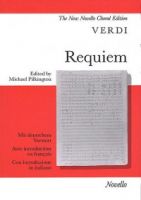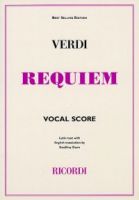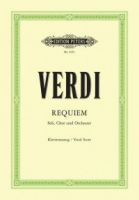Verdi Requiem Vocal Score
 Vocal Scores for Verdi's Requiem
Vocal Scores for Verdi's Requiem
The Novello/Pilkington vocal score for Verdi's Requiem is in Latin for SATB

Catalogue Number: NOV072403
ISBN: 9780853605430
Please click here if you wish to order and further vocal score information




The Ricordi edition of Verdi's Requiem is in English and Latin for SATB.

Catalogue Number: LD403P
ISMN: 9790570020102
Please click here if you wish to order and further vocal score information









The Messa da Requiem by Giuseppe Verdi is a musical setting of the Roman Catholic funeral mass Requiem for four soloists, double choir and orchestra. It was composed in memory of Alessandro Manzoni, an Italian poet and novelist much admired by Verdi. The first performance in San Marco in Milan on 22 May 1874 marked the first anniversary of his death. The work used to be called the Manzoni Requiem. It is typically not performed in the liturgy, but in a concert of around 85–90 minutes.
When Gioachino Rossini died in 1868, Verdi suggested that a number of Italian composers should collaborate on a Requiem in Rossini's honor, and began the effort by submitting the conclusion, Libera me. During the next year a Messa per Rossini was compiled by 13 composers, famous at the time, of whom the only one well known today is Verdi himself. The premiere was scheduled for 13 November 1869, the first anniversary of Rossini's death.
However, on 4 November, nine days before the premiere, the organising committee abandoned it. Verdi blamed the scheduled conductor, Angelo Mariani, for this. He pointed to Mariani's lack of enthusiasm for the project, even though he had been part of the organising committee from the start, and it marked the beginning of the end of their long-term friendship. Verdi never forgave Mariani, although Mariani pleaded with him.The piece fell into oblivion until 1988, when Helmuth Rilling premiered the complete Messa per Rossini in Stuttgart, Germany.
In the meantime, Verdi kept toying with his Libera me, frustrated that the combined commemoration of Rossini's life would not be performed in his lifetime.
In May 1873, the Italian writer and humanist Alessandro Manzoni, whom Verdi had admired all his adult life and met in 1868, died. Upon hearing of his death, Verdi resolved to complete a Requiem—this time entirely of his own writing—for Manzoni. Verdi travelled to Paris in June, where he commenced work on the Requiem, giving it the form we know today. It included a revised version of the Libera me originally composed for Rossini.
The Requiem was first performed the following May in the church of San Marco in Milan, on the first anniversary of Manzoni's death. Verdi himself conducted, and the four soloists were Teresa Stolz (soprano), Maria Waldmann (mezzo-soprano), Giuseppe Coppini (tenor) and Ormando Maini (bass). Stolz (Aida), Waldmann (Amneris) and Maini (Ramfis) had all sung in the European premiere of Aida in 1872, and Coppini was also intended to sing at that premiere (Radames) but was replaced due to illness. Teresa Stolz went on to brilliant career, Waldmann retired very young in 1875, and the male singers appear to have faded into obscurity. Teresa Stolz was also engaged to Angelo Mariani in 1869, but she later left him amid rumours (never substantiated) that she was having an affair with Verdi.
The Requiem won immediate contemporary success, although not everywhere. It received seven performances at the Opéra-Comique in Paris, but the new Royal Albert Hall in London could not be filled for such a Catholic occasion. In Venice, impressive Byzantine ecclesiastical decor was designed for the occasion of the performance.
It later disappeared from the standard choral repertoire, but made a reappearance in the 1930s and is now regularly performed as well as being a staple of many choral societies.
* 1. Introit and Kyrie (chorus, soloists)
* 2. Dies irae
o Dies irae (chorus)
o Tuba mirum (chorus, bass)
o Liber scriptus (mezzo-soprano, chorus)
o Quid sum miser (soprano, mezzo-soprano, tenor)
o Rex tremendae (soloists, chorus)
o Recordare (soprano, mezzo-soprano)
o Ingemisco (tenor)
o Confutatis (bass, chorus)
o Lacrimosa (soloists, chorus)
* 3. Offertory
o Domine Jesu Christe (soloists)
* 4. Sanctus (double chorus)
* 5. Agnus Dei (soprano, mezzo-soprano, chorus)
* 6. Lux aeterna (mezzo-soprano, tenor, bass)
* 7. Libera me (soprano, chorus)
Throughout the work, Verdi uses vigorous rhythms, sublime melodies, and dramatic contrasts—much as he did in his operas—to express the powerful emotions engendered by the text. The terrifying (and instantly recognizable) Dies irae that introduces the traditional sequence of the Latin funeral rite is repeated throughout for a sense of unity, which allows Verdi to explore the feelings of loss and sorrow as well as the human desire for forgiveness and mercy found in the intervening movements of the Requiem. Trumpets surround the stage to produce an inescapable call to judgement in the Tuba mirum (the resulting combination of brass and choral quadruple-fortissimo markings resulting in some of the loudest unamplified music ever written), and the almost oppressive atmosphere of the Rex tremendae creates a sense of unworthiness before the King of Tremendous Majesty. Yet the well-known tenor solo Ingemisco radiates hope for the sinner who asks for the Lord's mercy. Verdi also recycles and reworks the duet Qui me rendra ce mort? Ô funèbres abîmes!, from Act IV of Don Carlos, in the beautiful Lacrimosa which ends this sequence.
The joyful Sanctus (a complicated eight-part fugue scored for double chorus) begins with a brassy fanfare to announce him "who comes in the name of the Lord" and leads into an angelic Agnus Dei sung by the female soloists with the chorus. Finally the Libera me, the oldest music by Verdi in the Requiem, interrupts. Here the soprano cries out, begging, "Deliver me, Lord, from eternal death ... when you will come to judge the world by fire."
For further information of Verdi's Requiem, please click here to visit the Wikipedia website




ChoraLine 'Voice Part' Rehearsal CDs & EasyPlay (Stream & Download)
Quick and Easy way to memorise your vocal line and practise between choir rehearsals

Know Your Notes Perfectly
Enhance Your Enjoyment when Singing
Learn With The Music
Shine In Your Choir
Sing With Confidence
Please click here to hear a ChoraLine sample for the Requiem




Choral Performance CD
If you wish to have a CD of the Requiem to hear the whole work please click here and please do click on the video below to listen right away if you wish.




